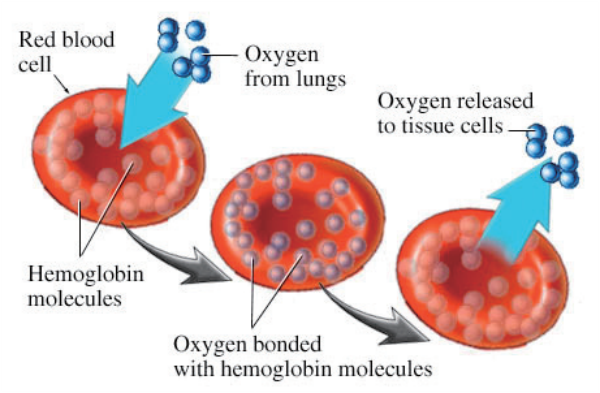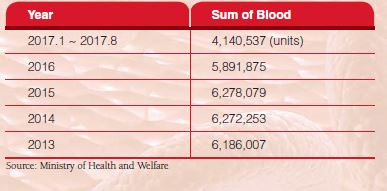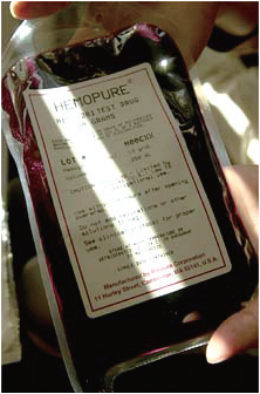It is particularly difficult to secure donated blood in the winter because the amount of blood donation decreases significantly compared to other seasons. This winter, in particular, the cold snap and the flu struck society simultaneously, and consequently the stocks of blood in Korea fell sharply to dangerously low levels. As a result, a number of institutional approaches are currently being considered to deal with the blood shortage, but it is possible to create an artificial blood as well. The Sungkyun Times (SKT) looks at the definition and history of artificial blood, necessity of it, and more details of its current position along with some ways of improvement.
A Need for Artificial Blood
Importance of Blood
Blood circulating the heart and blood vessels helps to protect and maintain life. It delivers oxygen from the lungs and nutrients from the stomach to the cells. In addition, it consists of white blood cells and antibodies which can fight against the viruses invading the body. If blood vessels are clogged in any part of the body, blood circulation will be poorer and the cells in that part will become infected and die. Usually around six liters of blood flows throughout the body of a male adult at any given time. If more than one third of the blood is lost, life can be in danger. Therefore, it is not too much to say that blood is indispensable for maintaining life.

Limitations of Securing Blood
The amount of blood in Korea is insufficient; according to the Korean Red Cross, the optimal blood reserve in Korea is 12,227 units, while the actual stock available is only 5,322 units, which is only about half of what is required. Even some urgent surgeries have been delayed due to the lack of blood, and patients who are not in a critical condition have need to wait or postpone their surgery. If a war occurs in this situation, people will need huge amounts of blood to heal wounds or perform emergency surgery, which would be almost impossible to get. There are two main reasons as to why securing blood is hard in the present situation. Firstly, blood obtained through donation has some restrictions. As of today, securing blood depends entirely on blood donations, but blood obtained through donation has the risk of transferring diseases such as Acquired Immune Deficiency Syndrome (AIDS) or hepatitis. Also, certain types of blood are extremely hard to acquire. A special blood type known as the RH-AB type, for instance, is only found in 0.2% of the Korean population. In addition, blood transfusions are restricted according to the blood types. Even if the same blood type is transfused, immune reactions can lead to unexpected problems as well.

Furthermore, the amount of blood donation itself has decreased. Blood donation has continued to decline, although there is no appropriate alternative to securing blood. According to data from the Ministry of Health & Welfare, blood supply has been steadily decreasing from 2014 to 2017. Furthermore, the 2016 Blood Services Annual Report showed that teenagers and those in their 20s accounted for more than 60% of all donors, with 27% of college students, 23% of high school students, and 15.8% of soldiers making up that percentage. Given that the youth population continues to decline, however, there is a high probability of a blood shortage within the next five years. Nam In- soon, councilor of the Democratic Party of Korea, also pointed out the low proportion of blood donation in the elderly, a warning of the high possibility of blood shortage in case the blood donation rate in the young falls. Therefore, in order to flexibly cope with these situations, there is an urgent need for the development of artificial blood.
Artificial Blood
History of Artificial Blood
The history of artificial blood dates back to the early 1900s, when blood types were first discovered and the features of blood types ABO were found. At that time, there were no attempts to make artificial blood because random blood transfusion showed serious side effects. After the blood type was found, however, people discovered that it is safe when the same blood type is transfused. People then naturally began to think of making blood artificially. During World War I, citrate was found to be safe and was used as artificial blood. After World War II and the Vietnam War, research on artificial blood was accelerated and promoted since a larger amount of blood was needed on the battlefield.

In 1962, Max Perutz, a professor of the University of Cambridge, proposed and began the development of artificial blood for the first time and received the Nobel Prize for Chemistry in the same year. The development of artificial blood, however, soon lost momentum in the face of serious side effects that could not be solved with the knowledge and technology at that time. Nonetheless, the definite lack of blood along with the discovery of AIDS in the 1980s became the catalyst for artificial blood development, which is safe from infection. Research was resumed, and people began to develop artificial blood that could be produced in large quantities. Since then, many developed countries have been working hard to produce artificial blood, and some of them are seeing good results.
Features of Artificial Blood
Although artificial blood cannot replace every aspect of real blood, it still has considerable advantages. Above all, it has a long expiration date. Compared to normal blood which can be stored for three weeks to 42 days, artificial blood can be kept fresh for one to three years. It also has a low sensitivity which makes it much easier to store. Normal blood should be stored in a refrigerator from two and six degrees Celsius to ensure the expiration date. Artificial blood, on the other hand, receives no disruption from the temperature for its expiration period. Moreover, artificial blood is easy to process. When real blood is sterilized, all the components of it are damaged and become unusable. Because the components of artificial blood are not damaged during sterilizing, however, it can reduce the risk of infections such as hepatitis and AIDS. Artificial blood is also useful for immediate blood transfusions in emergency situations because it is not restricted by blood type.

The Future of Artificial Blood
Status Quo of Artificial Blood
Currently, the global blood transfusion market is estimated to be approximately about $12 billion to $50 billion per year, which is also the potential market size for artificial blood. Therefore, research and development are ongoing, and high growth potential is expected in the future. In Korea, a biology company CHA Biotech has succeeded in making artificial blood using induced Pluripotent Stem cells (iPS) in cooperation with an American company Advanced Cell Technology (ACT). Currently, they are undertaking clinical trials in the United States (US). Scientists are also trying to combine life sciences technologies with artificial blood production, and Korea is expected to make a technological breakthrough soon. Moreover, a team of researchers from the Einstein University School of Medicine and the University of Tokyo are working together on stem cell research to create artificial blood. Although the initial artificial blood focused on only some functions of real blood, it is on now its way to move towards the full functionality of blood thanks to the development of technology.
Points to be Complemented
Despite its potential development, there are still three main points of artificial blood that need to be improved. First of all, its safety should be ensured. Artificial blood might have side effects such as vasoconstriction, contraction of blood vessels, and cause pain in the digestive system when injected into the body because the particles contained in the artificial blood may penetrate into the blood vessels and hinder contraction. To solve these side effects, it is necessary to clarify the mechanism of blood in the body more clearly. Hans Baumler, a professor of Charite Medical University, succeeded in developing artificial blood that does not show vasoconstriction. The results are currently going through clinical trials on animals; if they result in positive outcome, trials targeting humans will then proceed. In addition, it is also necessary for doctors who have decided to utilize artificial blood to know the exact state of artificial blood with the best efficacy, and the limitations and side effects of it. Secondly, its efficiency should be increased. Currently, the residence time of artificial blood is about 12 to 24 hours. Considering that natural blood can remain for 30 days when transfused, artificial blood is yet far from high efficiency. To be used variously and efficiently, it should be improved to a level that can stay in the body for about one week. The proposed methods include increasing the molecular weight and size of the polymer within artificial blood by attaching hemoglobin or other compounds.

Generated by combining hemoglobins which are out of date, Hemopure and Polyheme, for example, have been validated through clinical trials of four phases and are currently on the market with FDA approval. People should not stop at the level of developing those innovative products, but gradually improve them through the accumulation of technology. Lastly, it needs to strengthen its competitiveness in price. Artificial blood takes a long time to be researched and developed, and significant cost occurs for the development and clinical trials. Therefore, the current price of artificial blood is at least two to five times compared to that of ordinary blood. The price of natural blood is less than 40,000, while the price of Hemopure is more than 100,000. Therefore, in order to compete with natural blood, it is necessary for the price of artificial blood to be competitive.
In the near future, artificial blood will be an essential element in people’s lives. Perhaps, it may be possible for artificial blood to completely replace blood donation, even though not many people are aware of it yet. SKT, therefore, hopes that Kingos become more interested in artificial blood and more acquainted with related knowledge through this article.
